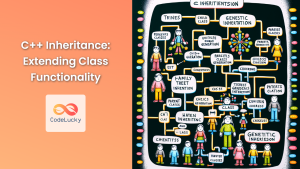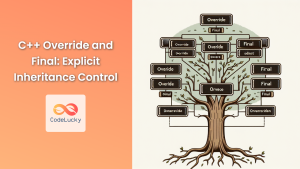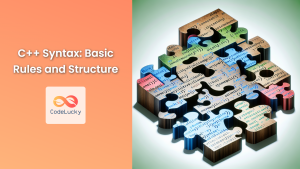In the world of C++, interfaces play a crucial role in defining contracts between different parts of a program. While C++ doesn't have a dedicated interface keyword like some other languages, it achieves the same functionality through abstract classes with only pure virtual functions. This powerful feature allows developers to create flexible and extensible code structures. Let's dive deep into the concept of interfaces in C++ and explore their implementation and benefits.
What is an Interface in C++?
An interface in C++ is essentially an abstract class that contains only pure virtual functions. It serves as a blueprint for other classes, defining a set of methods that derived classes must implement. This concept is fundamental to achieving abstraction and polymorphism in C++.
🔑 Key characteristics of a C++ interface:
- It's an abstract class
- Contains only pure virtual functions
- Cannot be instantiated directly
- Derived classes must implement all pure virtual functions
Let's start with a simple example to illustrate this concept:
class IShape {
public:
virtual double area() const = 0;
virtual double perimeter() const = 0;
virtual ~IShape() = default;
};
In this example, IShape is an interface. The = 0 syntax declares these functions as pure virtual, making IShape an abstract class that cannot be instantiated.
Implementing an Interface
To use an interface, we need to create concrete classes that inherit from it and implement all its pure virtual functions. Let's create two classes that implement the IShape interface:
class Circle : public IShape {
private:
double radius;
public:
Circle(double r) : radius(r) {}
double area() const override {
return 3.14159 * radius * radius;
}
double perimeter() const override {
return 2 * 3.14159 * radius;
}
};
class Rectangle : public IShape {
private:
double width, height;
public:
Rectangle(double w, double h) : width(w), height(h) {}
double area() const override {
return width * height;
}
double perimeter() const override {
return 2 * (width + height);
}
};
Now we have two concrete classes, Circle and Rectangle, both implementing the IShape interface.
Benefits of Using Interfaces
Interfaces in C++ offer several advantages:
- Abstraction: They allow you to define a contract without specifying the implementation details.
- Polymorphism: You can use pointers or references to the interface type to work with objects of different derived classes.
- Flexibility: New classes can be added that implement the interface without changing existing code.
- Testability: Interfaces make it easier to create mock objects for unit testing.
Let's demonstrate these benefits with a more complex example:
#include <iostream>
#include <vector>
#include <memory>
class ILogger {
public:
virtual void log(const std::string& message) = 0;
virtual ~ILogger() = default;
};
class ConsoleLogger : public ILogger {
public:
void log(const std::string& message) override {
std::cout << "Console: " << message << std::endl;
}
};
class FileLogger : public ILogger {
private:
std::string filename;
public:
FileLogger(const std::string& fname) : filename(fname) {}
void log(const std::string& message) override {
std::cout << "File (" << filename << "): " << message << std::endl;
}
};
class Application {
private:
std::vector<std::unique_ptr<ILogger>> loggers;
public:
void addLogger(std::unique_ptr<ILogger> logger) {
loggers.push_back(std::move(logger));
}
void doSomething() {
// Simulating some application logic
for (const auto& logger : loggers) {
logger->log("Application is doing something");
}
}
};
int main() {
Application app;
app.addLogger(std::make_unique<ConsoleLogger>());
app.addLogger(std::make_unique<FileLogger>("app.log"));
app.doSomething();
return 0;
}
In this example, we define an ILogger interface and two concrete implementations: ConsoleLogger and FileLogger. The Application class can work with any type of logger that implements the ILogger interface.
Output:
Console: Application is doing something
File (app.log): Application is doing something
This demonstrates how interfaces allow for flexible and extensible design. We can easily add new types of loggers without changing the Application class.
Advanced Interface Techniques
Let's explore some more advanced techniques and best practices when working with interfaces in C++.
Multiple Interface Inheritance
C++ allows a class to inherit from multiple interfaces, enabling a powerful form of multiple inheritance without the complexities of implementation inheritance.
class IDrawable {
public:
virtual void draw() const = 0;
virtual ~IDrawable() = default;
};
class IResizable {
public:
virtual void resize(int width, int height) = 0;
virtual ~IResizable() = default;
};
class Button : public IDrawable, public IResizable {
public:
void draw() const override {
std::cout << "Drawing button" << std::endl;
}
void resize(int width, int height) override {
std::cout << "Resizing button to " << width << "x" << height << std::endl;
}
};
This Button class implements both IDrawable and IResizable interfaces, allowing it to be used in contexts requiring either drawing or resizing capabilities.
Interface Segregation Principle
The Interface Segregation Principle (ISP) suggests that it's better to have many small, specific interfaces rather than a few large, general-purpose ones. Let's see an example:
// Instead of one large interface
class IAnimal {
public:
virtual void eat() = 0;
virtual void sleep() = 0;
virtual void fly() = 0;
virtual void swim() = 0;
virtual ~IAnimal() = default;
};
// We can split it into smaller, more focused interfaces
class IEater {
public:
virtual void eat() = 0;
virtual ~IEater() = default;
};
class ISleeper {
public:
virtual void sleep() = 0;
virtual ~ISleeper() = default;
};
class IFlyer {
public:
virtual void fly() = 0;
virtual ~IFlyer() = default;
};
class ISwimmer {
public:
virtual void swim() = 0;
virtual ~ISwimmer() = default;
};
// Now we can create more specific classes
class Bird : public IEater, public ISleeper, public IFlyer {
public:
void eat() override { std::cout << "Bird eating" << std::endl; }
void sleep() override { std::cout << "Bird sleeping" << std::endl; }
void fly() override { std::cout << "Bird flying" << std::endl; }
};
class Fish : public IEater, public ISleeper, public ISwimmer {
public:
void eat() override { std::cout << "Fish eating" << std::endl; }
void sleep() override { std::cout << "Fish sleeping" << std::endl; }
void swim() override { std::cout << "Fish swimming" << std::endl; }
};
This approach allows for more flexible and maintainable code, as classes only need to implement the interfaces relevant to their behavior.
Default Implementations in Interfaces
While interfaces typically contain only pure virtual functions, C++11 introduced the ability to provide default implementations for interface methods:
class ILoggable {
public:
virtual void log() const {
std::cout << "Default logging behavior" << std::endl;
}
virtual void setLogLevel(int level) = 0;
virtual ~ILoggable() = default;
};
class MyClass : public ILoggable {
public:
void setLogLevel(int level) override {
std::cout << "Setting log level to " << level << std::endl;
}
// MyClass can choose to override log() or use the default implementation
};
This feature can be useful for providing common functionality while still allowing derived classes to override if needed.
Best Practices for Using Interfaces in C++
When working with interfaces in C++, consider the following best practices:
-
🛠️ Use pure virtual destructors: Always declare the destructor of an interface as virtual and provide a default implementation.
-
🧩 Keep interfaces small and focused: Follow the Interface Segregation Principle to create more flexible and maintainable code.
-
🔒 Use interfaces to decouple components: Interfaces allow you to define clear boundaries between different parts of your system.
-
🏗️ Leverage interface-based programming: Design to interfaces rather than concrete implementations for more flexible and extensible code.
-
📚 Document interface contracts clearly: Provide clear documentation for each interface method, including any preconditions or postconditions.
-
🧪 Use interfaces for better testability: Interfaces make it easier to create mock objects for unit testing.
-
🔄 Consider using abstract base classes: For more complex scenarios, you might want to use abstract base classes that provide some implementation along with pure virtual functions.
Conclusion
Interfaces, implemented as abstract classes with only pure virtual functions, are a powerful feature in C++. They provide a way to define contracts between different parts of a program, enabling loose coupling, polymorphism, and extensibility. By mastering the use of interfaces, C++ developers can create more flexible, maintainable, and robust software systems.
Remember, while interfaces are a great tool, they're not always the best solution for every problem. Use them judiciously, considering the specific needs and constraints of your project. With practice and experience, you'll develop a keen sense of when and how to leverage interfaces effectively in your C++ code.
Happy coding! 🚀👨💻👩💻
















